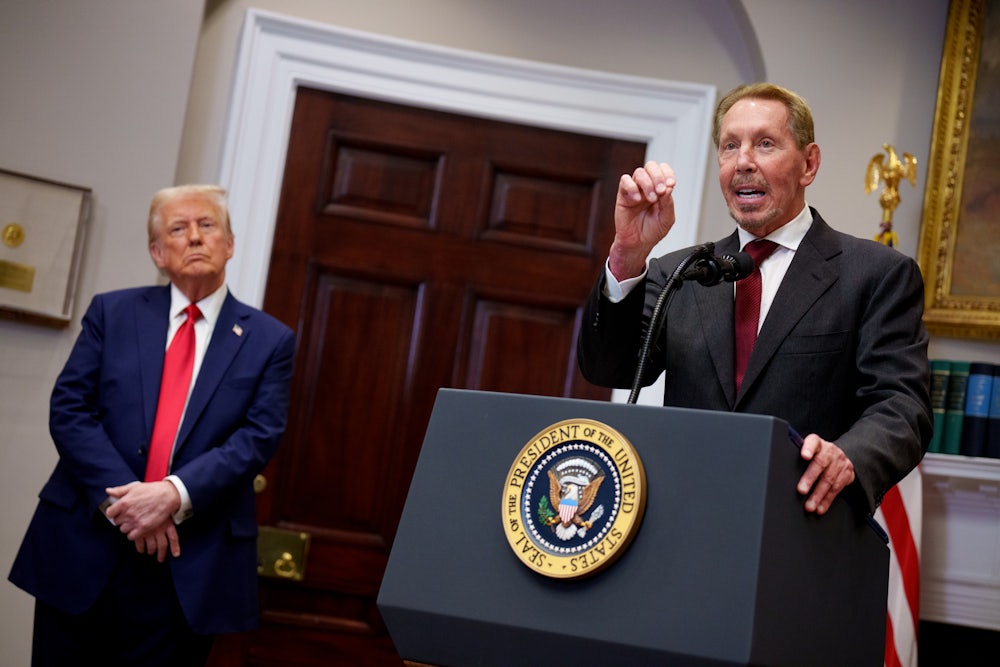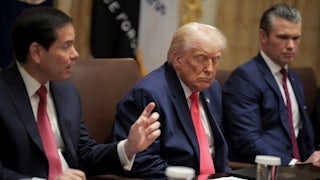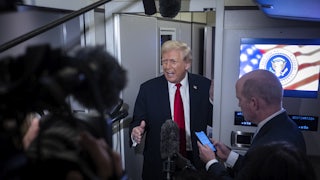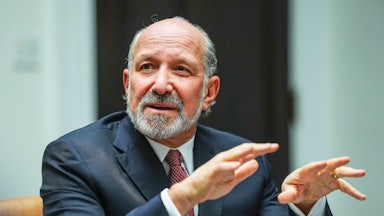On a recent trip through Florida, my Uber driver was intent on letting me know just how truly evil Nancy Pelosi is. I attempted to deflect, as I often do in such circumstances, but he persisted. Didn’t I think it was outrageous that Democrats want to raise rich people’s taxes? What about “abolishing the police”?
“A lot of people want something for nothing,” he said. “They want to get things for free. I don’t believe in that. I say if you don’t work, don’t come looking for handouts.”
He continued in this vein, sprinkling his anger and frustration with right-wing talking points on the scourge of immigrant criminals and the Biden crime family.
“Where did you hear that?” I finally asked when he got around to his spiel on open borders.
“They were talking about it on Fox News,” he said.
With unobtrusive questioning, I learned that he had worked in health care and was recently laid off. He was extremely concerned with keeping his car free of smudges and scuff marks because, as he told me, he found it very expensive to clean and maintain. When he wasn’t venting at the Democrats, he was bashing Uber. “They’re taking more and more from us drivers,” he said. “It’s impossible to make a living.”
It’s a tale as old as time. A skewed economic system delivers stress and frustration to a large group of people who previously imagined that they had a path to a decent life, and somehow all that rage gets channeled into a reactionary brand of politics.
It’s the “channeling” part of the story that interests me here. Rage is natural, but it isn’t a constant. It can be amplified—and it can be directed. That is pretty much what has been happening for the past two decades. And the channeling, while hardly monolithic, has worked overwhelmingly to the advantage of the authoritarian right wing. It is impossible to overstate the damage to American political culture of a rising right-wing media ecosystem, centered on Fox News. The question is not whether this is happening but why.
There was once a simple theory about media bias. It said that the problem with media is all about the kind of people who enter the profession of journalism. This has mostly been a cherished theory of the right, because the usual story is that journalists are, by nature, liberal types in an Amtrak corridor who view “real Americans” with contempt. But there is a left-wing version, which says that professional journalists are all “establishment” types militantly committed to perpetuating the status quo.
A second theory holds that the media has simply come to reflect the biases and polarization of the public. This story is usually accompanied with hoary truisms, like “for every Fox, there’s an MSNBC.” It’s the notion that media caters to partisans on left and right with equal fervor, dishing up whatever red or blue meat they would like.
A third idea blames it all on new technology, with the premise that social media and handheld devices, by their very nature, mess with people’s minds and produce a distorted media landscape.
These theories are incomplete at best. First, they fail to acknowledge that right-wing and left-wing media spheres are not equal and opposite poles of a symmetrical system. This fact has been proven in careful studies of reporting patterns across many years.
“The right is more insular, it is more extreme, and it is more partisan,” said the director of research at the Berkman Klein Center, which conducted one such study. Indeed, while both left- and right-wing media spread false stories, a summary of the research from the Harvard Kennedy School’s Shorenstein Center on Media, Politics and Public Policy notes, “Misinformation is currently predominantly a pathology of the right.” A study out of the University of Amsterdam, published earlier this year, asserts that far-right populist parties undermine democracy with misinformation as a matter of political strategy.
Importantly, the political impact of these two media spheres is not remotely comparable. One study, examining voting patterns among viewers in regions where Fox was off the air for technical reasons for certain periods indicates that Fox alone may have shifted between 3 percent and 6 percent of the votes in recent elections.
But perhaps the most important feature of the media landscape today comes down to money. Specifically, the endless, flowing river of oligarchic monopoly money.
Well-functioning media systems have generally included some kind of public constraint or oversight that keeps journalism from veering too far from its fundamental mission of informing the public. This public involvement can take the form of regulation (through broadcast licenses, for example), through support for large public broadcasting corporations (the BBC in the U.K., CBC in Canada), or through a variety of other mechanisms (like the old Fairness Doctrine in the United States).
In the U.S., public constraint on media has largely evaporated. But that doesn’t mean that the system has been handed over to “the market.” Today, for example, 40 percent of all local TV news stations are under the control of the three largest broadcast conglomerates: Sinclair Broadcast Group, Gray Television, and Nexstar Media Group. Their stations—each company now owns about 100 affiliated with ABC, CBS, FOX, or NBC—operate in more than 80 percent of U.S. media markets. A conglomerate with a distinct and well-documented right-wing bias, such as Sinclair, has an outsize footprint on our information ecosystem.
Under the Trump administration, the concentration of the media business has accelerated. And the administration has made it abundantly clear that the pathway to further consolidation involves pleasing (and funneling money to) the regime and its ruler. The news cycle related to Jimmy Kimmel’s exclusion and subsequent reinstatement has come and gone, but the real story endures. It was always fundamentally about securing regulatory approval for the CBS merger as a stepping stone to the CBS-Warner merger, which will leave us with a media behemoth under the thumb of Trumpy billionaire Larry Ellison, and his son, David.
Consider that Trump cleared the way for the Ellisons to merge their Skydance Media company with Paramount in order to gain control of CBS News. Thanks to this preferential treatment, the Ellisons’ new media giant is now in the running to purchase Warner Bros. Discovery, which includes the crown jewel of the media marketplace: CNN. Other companies adapt swiftly to the new cronyistic landscape. Comcast, which previously drew scrutiny from the Trump administration for its own efforts to purchase Warner Bros. Discovery, recently donated up to $10 million to fund Trump’s White House “renovation.”
It appears that these major media executives feel little need to satisfy any mission to genuinely inform the public. They want profits. And at least since the dawn of yellow journalism in the late nineteenth century, hate-based rage-bait has been seen as generally more profitable than information. The idea that such outlets are news organizations is increasingly quaint. Fox News blazed the trail when it reconceived the product that cable news produces: Instead of the straight story, information became fodder for entertainment, persuasion, and grievance. Under the direction of Roger Ailes, the outlet applied all the tricks of demagoguery to expand and consolidate its reach, including a hand-in-glove coordination with the GOP. This explains part—but only part—of the right-wing tilt in the media system.
The other part has to do with the kind of profits involved. The major media corporations in the U.S. aim for the kind of oligopoly profits that economists call “rents.” They make money by protecting their turf. The best way to protect their turf is to have governments that decline to regulate their anti-competitive moves—or, as in the present, that actively encourage anti-competitive outcomes that favor the regime. In short, they accumulate these rents by locking themselves into the economic and political structure.
One could argue that the mainstream media is not the only kid in town, and that the rise of social media, bloggers, and a thousand points of light on the internet have created a new landscape. But the role of the majors in anchoring the center and edges of national conversations should not be underestimated. My Florida Uber driver illustrates the point well. He was clearly picking up misinformation from a wide range of sources. But when it came to justifying his positions to me, he cited Fox News as holy writ.
A similar drive toward oligopoly profits is at play in the tech industry. The tech determinist narrative says that evil is built into the social media machine and its various hardware devices. But this just isn’t true. There is no natural law that says that social media, or any other technology, must be used for misinformation and manipulation. However, when you grant and enforce an effective monopoly to some technologist, they are likely to use just as much misinformation and manipulation as they can get away with to protect their privileged position.
One could still ask why a system that is so corrupted with money and regulatory policy would necessarily tilt to the right. The obvious answer is that the money that controls these corporations is in the hands of plutocrats, who generally favor right-wing governments because they want to keep as much of their money as possible—and prevent the little people from telling them what to do with it. Consider Peter Thiel, who identifies those who wish to end tax exemptions for the super-rich as possible representatives of “the antichrist.” Or consider Jeff Bezos, who is undermining The Washington Post’s long tradition of exemplary journalism by turning the Opinion section into an regime-friendly advocate for “personal liberties.”
But there’s a more subtle reason why these systems tilt away from progress and democracy. It’s because they are inherently corrupt and unreasonable. The last thing our tech, media, and corporate oligopolies want is an informed public, carrying on a rational debate about how we should govern ourselves. Their aim is to create dependence, and they succeed in doing so by filling up Uber drivers and others with narratives that appeal to resentment and frustration. The best way to control people, after all, is to get them to control themselves.
The main solutions, I hope, are clear. Let’s not pretend this can all be overcome simply by reducing partisan divides and promoting civility. And let’s set aside the idea that a few new apps to limit screen time or tame the worst bits of social media will have much of an effect. The fundamental problem is money and control. We need to confront and challenge media and tech oligopolies and establish a system that produces journalism committed to the goal of any free press, which is to inform the public and promote the truth.










